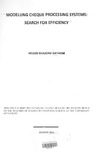| dc.contributor.author | Gathoni, Hellen N | |
| dc.date.accessioned | 2013-03-01T05:44:42Z | |
| dc.date.issued | 2011 | |
| dc.identifier.citation | Masters of science in computer science | en |
| dc.identifier.uri | http://erepository.uonbi.ac.ke:8080/xmlui/handle/123456789/12690 | |
| dc.description.abstract | Cheque clearing process takes a long time thus lagging behind the country's economy.
This is even worse for cheques collected from Upcountry's and remote areas as clearing
takes 10 and 14 days respectively. The existing cheque clearing system takes 4 days for a
cheque to clear and 6 days for a dishonoured cheque to get to the presenting branch
within the local areas and 15 days to 21 days for upcountry and remote areas
respectively. This called for need to adopt cheque truncation that has been
implemented in many countries. In Kenya the process will reduce clearing cycle to two
from four days taken to process cheque issued in major towns and to 4 days from 10
and 14 days respectively the number of days for clearing upcountry and remote cheques
[Kenya Bankers Association (KBA)chief executive Habil Olaka said in an interview]. This
has called the need for an efficient clearing system that will reduce clearing days to 1
irrespective of geographical locations of bank branches within the country. Thus the
project aims at modelling cheque processing in search for efficiency.
To model a modified model to achieve efficiency the researcher used data gathering
techniques such as document scan, interviews and observation to understand the
existing processes from the time a cheque is deposited to the time its cleared or
returned. Simulation technique was used to model both the existing and the modified
model which was implemented using MATLAB simulation software and hence
implementation of computer science concepts.
The modified models allows for image processing by truncating cheques at the branch
level thus controlling processing of physical cheques and truncation of cheques when
they get to CPC thus eliminating redundancy of capturing images which slow cheque
processing. Optical character readers (OCR)also introduced at CPC allows for auto
reconciliation of masked amount and code lines unlike before where it was done
manually. This is reduced error rate of processed cheque from 12.89% to 4.04% as most
the clearing errors previously detected on the second day are worked on at the time of
cheque presentation thus an improved measure of efficiency. | en |
| dc.description.sponsorship | University of Nairobi | en |
| dc.language.iso | en | en |
| dc.publisher | University of Nairobi | en |
| dc.subject | Modelling | en |
| dc.subject | cheque processing systems | en |
| dc.title | Modelling cheque processing systems: search for efficiency | en |
| dc.type | Thesis | en |
| local.publisher | School of Computing and Informatics | en |

